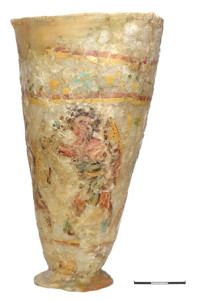 Moshkova M.G.*, Treister M.Y.**
Moshkova M.G.*, Treister M.Y.**
* Institute of archaeology RAS, Moscow
** Freie Universität Berlin, Institut für Vorderasiatische Archäologie
(mikhailtreister@yahoo.de)
Key words: Western Kazakhstan, Lebedevka, nomads, Roman imports, Bagram, glass goblet, gladiators.
The article is devoted to the find of the unique glass vessel with the enamel painting in the burial 1 of the barrow 23 of the burial cemetery Lebedevka V in the Western Kazakhstan. The context of the find examined thoroughly allows dating back to the middle of the 3rd c. AD. A lot of attention was paid to the description and attribution of the glass vessel with the picture of four gladiators belongs to the group of vessels of an exquisite quality, which were very likely to be produced in the Middle East, and bears a strong resemblance to one in the treasury of Bagram (Afghanistan). The dating of such kind of vessels might cause an argument. Different researches suggest dates within the period of the end of the 1st – the first half of the 3rd cc. AD. Taking into consideration that such a fragile piece of art is unlikely to be kept and passed on from generation to generation in the nomadic community both its late dating within the period of the chronology and referring the goblet from Bagram to the second half of the 2nd c. AD are more likely to be. In conclusion, the find is considered in the context of the numerous import items of the western and eastern origin found in Lebedevka V.







